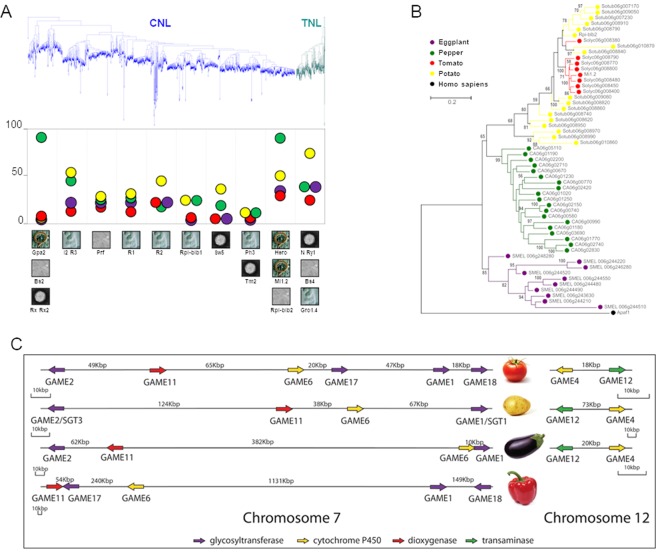Figure 6.
Gene family evolution in the Solanaceae. (A) Phylogenetic tree of CNL (in blue) and TNL (in green) NB-LRR genes. The distinctive evolutionary dynamics of ten NB-LRR groups in eggplant (purple), potato (yellow), tomato (red) and pepper (green) genomes are displayed. The number of NB-LRR genes included in each group is indicated on the vertical axis. The plant pathogens (fungi, virus, bacteria or nematodes) to which known genes in the clade confer resistance are indicated by pictures. Gro1.4 and Hero confer resistance to Globodera rostochiensis. Gpa2 and Mi1.2 confer resistance to Globodera pallida and Meloidogyne incognita, respectively. Rx and Rx2 confer resistance to Potato Virus X. N, Ry1, Tm2 and Sw5 confer resistance to Tobacco Mosaic Virus, Potato Virus Y, Tomato Mosaic Virus and Tomato Spotted Wilt Virus, respectively. Bs2 and Bs4 confer resistance to Xanthomonas campestris and Prf to Pseudomonas syringae. Rpi-blb1, Rpi-blb2, R1, R2 and R3 confer resistance to Phytophthora infestans and I2 to Fusarium oxysporum. (B) Independent expansion of Mi1.2/Rpi-blb2 homologous genes in eggplant, pepper, potato and tomato. The human APAF1 (Apoptotic Protease Activating Factor 1), is a human cytoplasmic protein showing similar structure to nucleotide binding site–leucine rich repeat proteins of plants, and was used to re-root the tree of plant NLR phylogenetic analysis40,79. (C) The steroidal glycoalkaloid metabolic gene cluster in four Solanaceous genomes. In tomato, six genes (GAME1, GAME2, GAME6, GAME11, GAME17, GAME18) are located on CH7 and two (GAME4 and GAME12) on CH12. In potato, four-SGA associated genes (SGT3, GAME6, GAME11 and SGT1/GAME1) are found in CH7 and two in CH12 (GAME4 and GAME12). In eggplant, four putative SGA genes namely, GAME1/SGT1, SGT3, GAME6 and GAME11 are also physically linked to each other on CH7 and two, GAME4 and GAME12 on CH12. In pepper, five genes (GAME1, GAME6, GAME11, GAME17 and GAME18) were found to be present on CH7. GAME4 and GAME12 homologous sequences were not detected in the pepper genome.

